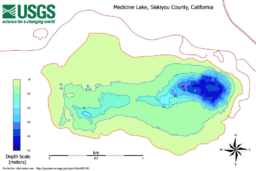Medicine Lake Volcano facts for kids
Quick facts for kids Medicine Lake Volcano |
|
|---|---|

Medicine Lake volcano as seen from Lava Beds National Monument
|
|
| Highest point | |
| Elevation | 7,921 ft (2,414 m) NAVD 88 |
| Geography | |
| Location | Siskiyou County, California, U.S. |
| Parent range | Cascade Range |
| Topo map | USGS Medicine Lake |
| Geology | |
| Age of rock | about 500,000 years |
| Mountain type | Shield volcano |
| Volcanic arc | Cascade Volcanic Arc |
| Last eruption | 1080 ± 25 years |
| Medicine Lake | |
|---|---|

The lake with Mount Shasta in the background
|
|

Bathymetric map
|
|
| Location | California |
| Coordinates | 41°34′54″N 121°35′56″W / 41.58167°N 121.59889°W |
| Basin countries | United States |
| Max. length | 0.6 mi (1 km) |
| Max. width | 1.2 mi (2 km) |
| Surface area | 0.64 sq mi (1.65 km2) |
| Average depth | 24.0 ft (7.3 m) |
| Max. depth | 152 ft (46.4 m) |
| Water volume | 470,000,000 cu ft (13,400,000 m3) |
| Shore length1 | 20,384 ft (6,213 m) |
| 1 Shore length is not a well-defined measure. | |
The Medicine Lake Volcano is a very large shield volcano in northeastern California, USA. It is about 30 miles (50 km) northeast of Mount Shasta. This volcano is part of the Cascade Volcanic Arc, a chain of volcanoes in the western United States.
A shield volcano gets its name because it looks like a warrior's shield lying on the ground. It has gentle slopes formed by many lava flows. Medicine Lake Volcano is huge, covering more than 770 square miles (2,000 km2). Its thick shield is about 22 miles (35 km) wide from east to west and up to 31 miles (50 km) from north to south.
This volcano rises about 3,900 feet (1,200 m) above the land around it, reaching a height of 7,795 feet (2,376 m). The amount of lava that has flowed from Medicine Lake Volcano is estimated to be at least 140 cubic miles (600 km3). This makes it the largest volcano by volume in the Cascade Range. Lava Beds National Monument is located on the northeast side of the volcano.
Medicine Lake Volcano has been active for about 500,000 years. Its eruptions were usually gentle, not explosive like Mount St. Helens. This means lava slowly flowed down its sides, building up the shield shape. Scientists believe Medicine Lake Volcano is special because it has many small pockets of molten rock (magma) instead of one big one.
What is a Caldera?
Medicine Lake itself is located inside a large bowl-shaped area called a caldera. This caldera is about 4 miles (7 km) by 7 miles (12 km) wide. A caldera forms when a volcano's magma chamber empties during an eruption, causing the ground above it to collapse.
For Medicine Lake, the caldera likely formed over a long time from many smaller collapses. This happened as different types of lava erupted from vents around the rim of the caldera. The small lake that gives the volcano its name sits right in the middle of this caldera.
History of Eruptions
Early Volcano Activity
Medicine Lake Volcano started to grow about one million years ago. Since then, it has had many eruptions. Most of the lava flows on the lower parts of the volcano are made of basalt, a dark, runny type of lava. Higher up, you find more andesite and rhyolite, which are thicker lavas.
Over the last 11,000 years, the volcano has erupted in bursts. For example, about 10,500 years ago, there were eight eruptions that produced a lot of basalt lava. Then, there was a quiet period before a smaller eruption happened about 4,300 years ago.
More recently, between 3,000 and 900 years ago, there were eight more eruptions. These eruptions produced different types of lava, from basalt to rhyolite. Many of the vents where lava erupted are lined up along cracks in the Earth's crust.
Glass Mountain
The most recent eruption at Medicine Lake Volcano happened about 1,000 years ago. This eruption created a unique area called Glass Mountain. It is made of rhyolite and dacite lava, which cooled quickly to form obsidian, a natural glass.
Glass Mountain is a striking, mostly treeless, steep-sided lava flow. It erupted just outside the eastern rim of the caldera and flowed down the volcano's side. There are also several smaller domes of similar lava nearby. Scientists have used radiocarbon dating on a tree found in the lava flow to figure out its age. This helps them understand when the eruption happened.




